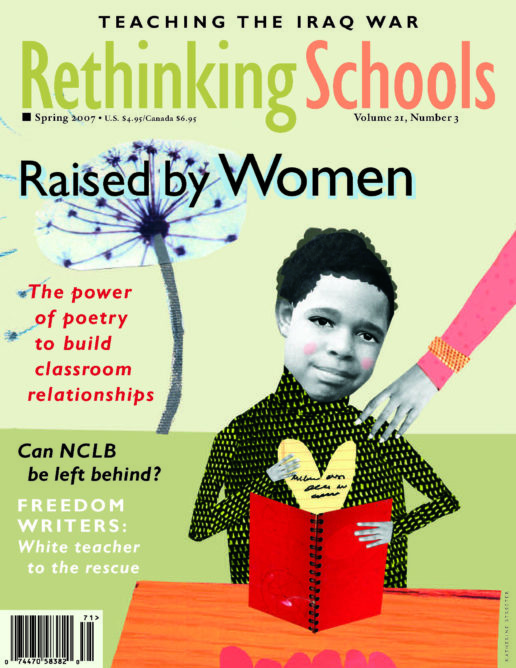Reviews
BOOKS
Diamonds, Guns, and Rice

Speaking Out: Women, War, and the Global Economy
By Jan Haaken and others
Includes a DVD of the film
Diamonds, Guns and Rice: Sierra Leone and the Women’s Peace Movement
(Ooligan Press, 2005. www.publishing.pdx.edu)
$19.95 paperback
Groups of student “diamond workers” are clustered around an egg-carton game board, shifting the pieces — representing diamonds — from bowl to bowl. In the simulation, rooted in a traditional African game, students carefully devise strategies for the shifts, trying to get the most pieces in a larger end bowl. Finally, the victorious student draws a “penalty card” replicating a real-world event, such as being attacked by rebels and losing half of her diamonds; the student then is told that most of her remaining diamonds are owned by a diamond cartel partner, who gains almost all of the profit from the worker’s effort. Debriefing, students respond to the injustice and look at the system that creates it. Thus are students introduced to the global diamond trade.
This lesson comes from a new film and curriculum for high school and college students. The film, Diamonds, Guns and Rice, and the curriculum, Speaking Out, use the 1990s civil war in Sierra Leone to explore broader issues such as cross-cultural awareness, the global trade in diamonds and guns, and the effects of war on women. Given the paucity of material on contemporary Africa, let alone on women or globalization, the package is a welcome contribution.
The 1991-1999 civil war in Sierra Leone, like the related war in neighboring Liberia, was not so much a classic revolution against oppression as it was a multi-sided struggle for power that often degenerated into brutal terrorism. As in other recent wars, many children became soldiers — some through kidnapping, others because they were attracted to the power of being with an armed force. As the curriculum notes, “Since youths played such a leading role in the Sierra Leonean civil war, including carrying out atrocities in their own villages, post-conflict interventions have focused heavily on the young.” But where most efforts are directed toward male combatants, Speaking Out looks at the “daunting barriers faced by girl combatants in the aftermath of the civil war.”
The film has three sections: “Rice,” which looks at the role of both rice and women in Sierra Leonean culture; “Guns and Diamonds,” which gives an overview of the war, its causes and its horrendous effects; and “Peace,” which explores the efforts to reintegrate child soldiers after the war.
The curriculum expands on most of the themes from the film. Divided into four sections, three of which connect directly to the film, the curriculum offers content background as well as activities to enhance the film. Each section has a helpful introduction, while each lesson has specific classroom procedures and handouts.
Reconciliation and Reintegration
Particularly interesting is the focus in both the film and curriculum on reconciliation, not through platitudes about peace, but through confronting the difficult issues of reintegrating child soldiers into a community and the conditions under which people should be forgiven for horrendous crimes. In the key lesson, students are asked to role-play village elders — drawn from real people — who consider whether and how to allow child soldiers back into the village. The specifics of the stories offer insights into the different perception of children in Sierra Leonean society, and give students the opportunity for a complex discussion of the limits of forgiveness, even for children.
A second role play brings students back to globalization, by holding a mock trial of both the DeBeers diamond corporation and small arms manufacturers who made the weapons that created so much devastation in Sierra Leone. Student prosecutors, defenders, and judges confront the questions of how much responsibility those distant corporations have for the war. Does DeBeers’ buying of diamonds from various armed groups mean they funded the war? Did the gun manufacturers who didn’t care who bought their guns aid the violence?
The film is accessible to high school students and is a useful learning tool, particularly when used with the curricular lessons. In addition to helping explore broad issues, it humanizes and individualizes Africans, portraying their depth and intelligence, rather than just picturing them as generic victims.
The curriculum is well organized and easy to follow. High school teachers, however, may want to adapt some of the more academic readings in the curriculum, which tend to presume background knowledge and demand advanced vocabulary. It would also be helpful to provide more specifics on the nature of the World Bank and International Monetary Fund. These global agencies, which shaped Sierra Leonean government policies that helped impoverish the country, are included among the causes of the civil war, but are not adequately introduced.
Overall, the film and curriculum cover issues that teachers rarely have material for. At a cost of $19.95 for the curriculum and a DVD of the film, it’s a bargain.

